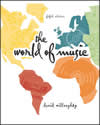|
 |  The World of Music, 5/e David Willoughby
Introducing the World of Music
Chapter 1:
| Global perspective | A worldwide point of view, including an awareness of and respect for the life-styles, traditions, values, and arts of nations and cultures.
|  |  |  | | American mainstream | The American mainstream began with the English settlers to the New World in the seventeenth and eighteenth centuries. As time went on other immigrant groups became a part of this mainstream by assimilating with this majority culture. Those groups that held on stronger to their language, customs and values are called ethnic minorities. The intersection of the majority mainstream and the ethnic minorities’ culture are what provide the country with its diversity. As these different cultures merge, new styles and behavior occur. Jazz music stems from such an intersection.
|  |  |  | | Immigration and ethnic diversity | Immigrant groups assimilate with the majority culture in order to fit it or risk becoming isolated. For those groups that retain parts of their cultural characteristics such as their language, views and customs, they form ethnic minorities. The variety of these cultures form the ethnic diversity of an area.
|  |  |  | | Cultural characteristics | These include a culture’s language, customs, social views, artistry, lifestyles, and food.
|  |  |  | | Labels | These are useful sometimes in organizing large amounts of information, styles, people and concepts. This textbook does use labels; however, we recognize that the use of labels can be ambiguous at times. Sometimes labeling is not so easy in the world of music. A song which may be categorized as popular music may also overlap in another category as well.
|  |  |  | | Artists and artistry | An artist is one who performs in whatever medium with creativity and sensitivity and with the ability to communicate with an audience. In music, artistic performance applies to all styles. In addition performers that are well-known or known by few all make up the artistry of a discipline.
|
|
|



 2003 McGraw-Hill Higher Education
2003 McGraw-Hill Higher Education